Nicole schreibt...
Burma (Myanmar) 2004/2005 |
 |
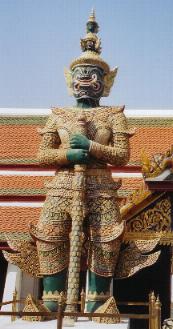 My interest in Burma (these days known as Myanmar) was first woken by John Boorman's excellent movie Beyond Rangoon in which he charts the adventures of a young American woman who gets embroiled in the uprising against the military government in 1988 - the events that saw Aung San Suu Kyi emerge as her people's leader. Though democratically elected, the military government that has ruled Burma for fifty years now, still denies her and her party any power. Therefore a trip to Burma also has a political aspect for the government that so terribly oppresses its people naturally profits from the tourist dollar. In my opinion however the profits generated by tourism could hardly keep the government in power, it's the billions other regimes like the Chinese pump into Burma that does it. And these days politicians, managers and tourists all flock to China, the rising world power. So talk about hypocrisy. Furthermore, almost forty years of complete isolation only served the regime for hardly anyone in the world cares about Burma or even knows where in the world it is and the country itself, once one of the richest countries in Asia, is now on the list of the world's least-developed nations. Tourism at least brings Burma back in touch with the rest of the world and in recent years satellite television, international newspapers and the internet have arrived, bringing outside information into the country. Although the general state of Burma is of course terrible, the unspoilt nature and old Asian lifestyle form a big attraction and it had always been my wish to see the country before McDonald's and the rest of the Western commercial blight arrives. Having finally found a small tour group, I left for Bangkok on Tuesday, 28 December, two days after the earthquake and tsunami brought devastation and tragedy to Asia.
My interest in Burma (these days known as Myanmar) was first woken by John Boorman's excellent movie Beyond Rangoon in which he charts the adventures of a young American woman who gets embroiled in the uprising against the military government in 1988 - the events that saw Aung San Suu Kyi emerge as her people's leader. Though democratically elected, the military government that has ruled Burma for fifty years now, still denies her and her party any power. Therefore a trip to Burma also has a political aspect for the government that so terribly oppresses its people naturally profits from the tourist dollar. In my opinion however the profits generated by tourism could hardly keep the government in power, it's the billions other regimes like the Chinese pump into Burma that does it. And these days politicians, managers and tourists all flock to China, the rising world power. So talk about hypocrisy. Furthermore, almost forty years of complete isolation only served the regime for hardly anyone in the world cares about Burma or even knows where in the world it is and the country itself, once one of the richest countries in Asia, is now on the list of the world's least-developed nations. Tourism at least brings Burma back in touch with the rest of the world and in recent years satellite television, international newspapers and the internet have arrived, bringing outside information into the country. Although the general state of Burma is of course terrible, the unspoilt nature and old Asian lifestyle form a big attraction and it had always been my wish to see the country before McDonald's and the rest of the Western commercial blight arrives. Having finally found a small tour group, I left for Bangkok on Tuesday, 28 December, two days after the earthquake and tsunami brought devastation and tragedy to Asia.
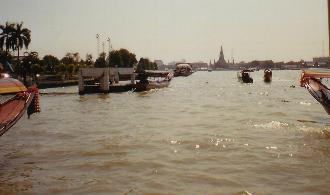 Arriving early the next morning, I decided to take it easy on my first day in the Thai capital. Taking the new Skytrain into the commercial city center, I went on a shopping tour around Bangkok's malls and Pratunam Market, one of the big open air markets mainly known among tourists for selling all sorts of fake designer goods. It's interesting to see that a few years ago it were mainly upmarket brands like Rolex, Louis Vuitton on Cartier that were being pirated while now it's trendy pop culture brands such as Diesel, Von Dutch and Billabong. My hotel had a swimming pool on the roof and offered Thai Massage for as little as 15$ per hour, so I returned early in the afternoon to chill.
Arriving early the next morning, I decided to take it easy on my first day in the Thai capital. Taking the new Skytrain into the commercial city center, I went on a shopping tour around Bangkok's malls and Pratunam Market, one of the big open air markets mainly known among tourists for selling all sorts of fake designer goods. It's interesting to see that a few years ago it were mainly upmarket brands like Rolex, Louis Vuitton on Cartier that were being pirated while now it's trendy pop culture brands such as Diesel, Von Dutch and Billabong. My hotel had a swimming pool on the roof and offered Thai Massage for as little as 15$ per hour, so I returned early in the afternoon to chill.
 Next morning it was time for sightseeing. Since Bangkok's traffic jams are legendary I took a river express boat up Chao Praya river, past the fancy hotels and Wat Arun, the temple of dawn, to the splendid area of the Grand Palace where the Thai kings resided after the Burmese destroyed their old capital Ayutthaya. The complex is also home of Wat Phra Kaew, the Emerald Buddha (the Thai-Buddhist equivalent of St.Peter's cathedral) and the powers that be don't make it easy for tourists.
Next morning it was time for sightseeing. Since Bangkok's traffic jams are legendary I took a river express boat up Chao Praya river, past the fancy hotels and Wat Arun, the temple of dawn, to the splendid area of the Grand Palace where the Thai kings resided after the Burmese destroyed their old capital Ayutthaya. The complex is also home of Wat Phra Kaew, the Emerald Buddha (the Thai-Buddhist equivalent of St.Peter's cathedral) and the powers that be don't make it easy for tourists.
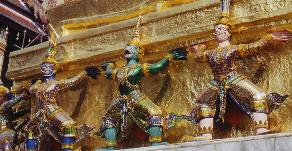 In anticipation of temple dress codes I had made sure I was wearing a long-sleeved shirt and a long skirt but found that flip-flops are a no-no as well, so I had to queue to rent a pair of sandals with backstrap (and to rent those, they first make you pay for a pair of socks!). Luckily it was early in the morning, so the queue wasn't long. When I left the complex later, the queue seemed half a mile long!
I also visited Wat Pho nearby which is home to a 46 metre-long reclining Buddha. Try and get that one on a photo!
In anticipation of temple dress codes I had made sure I was wearing a long-sleeved shirt and a long skirt but found that flip-flops are a no-no as well, so I had to queue to rent a pair of sandals with backstrap (and to rent those, they first make you pay for a pair of socks!). Luckily it was early in the morning, so the queue wasn't long. When I left the complex later, the queue seemed half a mile long!
I also visited Wat Pho nearby which is home to a 46 metre-long reclining Buddha. Try and get that one on a photo!
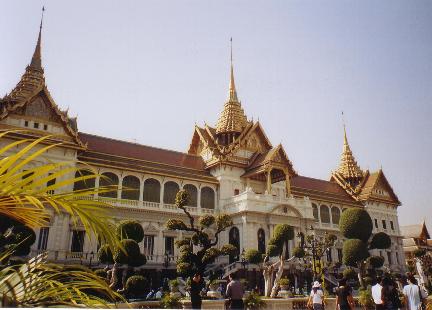
|
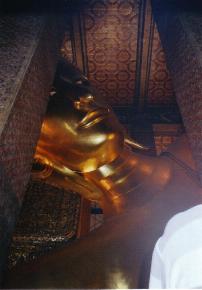 |
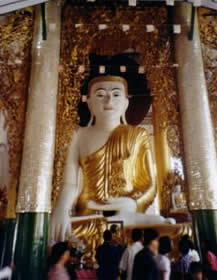 After arriving in Yangon and checking into the gorgeous Kandawgyi Palace Hotel on the
shore of Lake Kandawgyi, I ventured into the town on my own in order to change money. The government once fixed the exchange rate at 6 Kyat per dollar and there it has remained ever since. These days, a dollar will get you 800-900 Kyat on the black market, so every tourist who has bothered to read his travel guide knows he has to find one of the moneychangers at Sule Pagoda or else get screwed over completely. With a whole wad of 1000-Kyat notes in my purse I decided to stroll around the old colonial center of Yangon and here reality of life in Burma hit me, seeing the decaying houses, the debris and rubble everywhere and the contents of shops reminiscent of the GDR in the mid 80's. In the end I was glad I found a mini-mart that sold cans of Coca-Cola and headed back to the hotel and its swimming pool.
After arriving in Yangon and checking into the gorgeous Kandawgyi Palace Hotel on the
shore of Lake Kandawgyi, I ventured into the town on my own in order to change money. The government once fixed the exchange rate at 6 Kyat per dollar and there it has remained ever since. These days, a dollar will get you 800-900 Kyat on the black market, so every tourist who has bothered to read his travel guide knows he has to find one of the moneychangers at Sule Pagoda or else get screwed over completely. With a whole wad of 1000-Kyat notes in my purse I decided to stroll around the old colonial center of Yangon and here reality of life in Burma hit me, seeing the decaying houses, the debris and rubble everywhere and the contents of shops reminiscent of the GDR in the mid 80's. In the end I was glad I found a mini-mart that sold cans of Coca-Cola and headed back to the hotel and its swimming pool.
 The round trip began the next day with a visit to Yangon's (and indeed Burma's) most famous monument, the Shwedagon Pagoda. On photos it often seems as if the "pagoda" consists of a single building covered by the enormous golden stupa, but in reality it is a whole complex of pagodas, temples, statues and stupas. I swear I've never seen anything like the splendour of the Shwedagon, which formed a stark contrast to the shoddy state of downtown Yangon, too. The complex had its funny sides, too, like the army of broom-sweepers that first assemble in one temple for before setting out to clean the floors or the people who light cigarettes instead of joss sticks in front of Buddha statues.There were very few tourists around, but faithful Buddhists in droves, praying in temples, bringing offers and donating money in their efforts to garner merit for their next life.
The round trip began the next day with a visit to Yangon's (and indeed Burma's) most famous monument, the Shwedagon Pagoda. On photos it often seems as if the "pagoda" consists of a single building covered by the enormous golden stupa, but in reality it is a whole complex of pagodas, temples, statues and stupas. I swear I've never seen anything like the splendour of the Shwedagon, which formed a stark contrast to the shoddy state of downtown Yangon, too. The complex had its funny sides, too, like the army of broom-sweepers that first assemble in one temple for before setting out to clean the floors or the people who light cigarettes instead of joss sticks in front of Buddha statues.There were very few tourists around, but faithful Buddhists in droves, praying in temples, bringing offers and donating money in their efforts to garner merit for their next life.

|
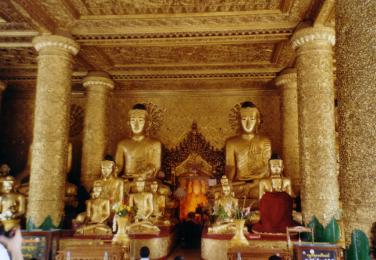 |
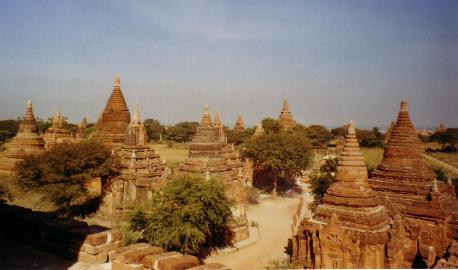 Bagan, home of the Burmese kings many centuries ago, is now one of the most fascinating archeological sites of Asia. Strewn across an area of roughly 30 square miles are hundreds of pagodas of all shapes and materials from stone to teak wood. Many stupas were shiny white or covered in gold and almost every little pagoda still contained a Buddha statue. Looking over the serene landscape I was really glad that I was able to enjoy this sight before the big tourist stampedes will arrive. I don't want to know what Bagan will be like once tourism gets going in Burma. Many of the old fragile buildings will probably be closed to the public, while the Bagan mini train choo-choo's around the pagodas, the "John was here!" graffittis spring up everywhere and the McPagoda Burger is on sale from the horse-drawn carriage drive-in.
The day ended quietly with a boat trip on the Irawaddy River to watch the sun set behind the hills.
Bagan, home of the Burmese kings many centuries ago, is now one of the most fascinating archeological sites of Asia. Strewn across an area of roughly 30 square miles are hundreds of pagodas of all shapes and materials from stone to teak wood. Many stupas were shiny white or covered in gold and almost every little pagoda still contained a Buddha statue. Looking over the serene landscape I was really glad that I was able to enjoy this sight before the big tourist stampedes will arrive. I don't want to know what Bagan will be like once tourism gets going in Burma. Many of the old fragile buildings will probably be closed to the public, while the Bagan mini train choo-choo's around the pagodas, the "John was here!" graffittis spring up everywhere and the McPagoda Burger is on sale from the horse-drawn carriage drive-in.
The day ended quietly with a boat trip on the Irawaddy River to watch the sun set behind the hills.
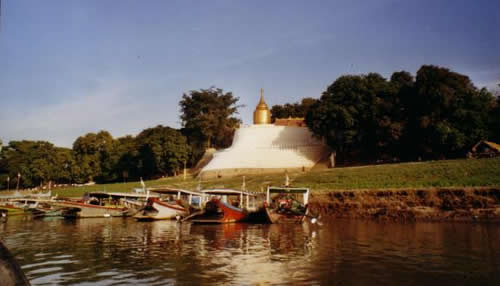
|
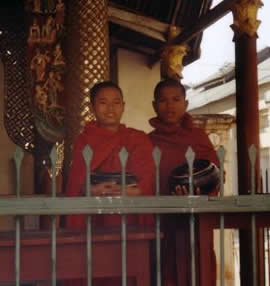 |
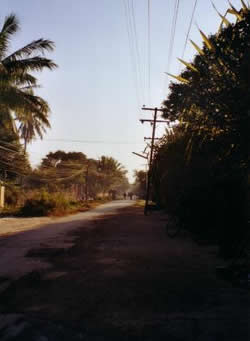 Kipling wrote poetry about it, Robbie Williams sang about it, but in reality the "Road to Mandalay" was little more than a dust track and tourists arrive by plane.
Mandalay, like Casablanca, is one of those places whose very name seems synonymous with exotic far-away locations and one of the main tourist destinations in Burma. The town was founded in 1857 only after King Mindon in his residence in nearby Amarapura had a particularly funky dream in which he was told that he should build a new palace at the foot of Mandalay Hill.
Kipling wrote poetry about it, Robbie Williams sang about it, but in reality the "Road to Mandalay" was little more than a dust track and tourists arrive by plane.
Mandalay, like Casablanca, is one of those places whose very name seems synonymous with exotic far-away locations and one of the main tourist destinations in Burma. The town was founded in 1857 only after King Mindon in his residence in nearby Amarapura had a particularly funky dream in which he was told that he should build a new palace at the foot of Mandalay Hill.
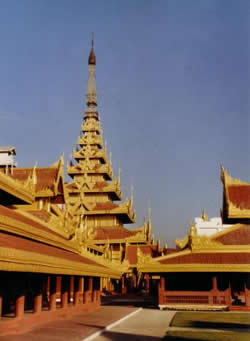 King Mindon had parts of his old palace in Amarapura dismantled and set up fresh in Mandalay, but it didn't do him much good. The British ransacked the palace in 1885, when they also sent his son and successor King Thibaw into exile to India to claim Burma as a British colony. They used the palace as a fort, before most of the wooden structures burnt down during a Japanese attack in World War II.
What's on display now is a very fresh reconstruction from the 1990s that was also very much devoid of visitors, so it was both eerie and amazing to feel like you had the whole royal palace to yourself and could try to conjure up images of life at the Burmese court in 19th century.
King Mindon had parts of his old palace in Amarapura dismantled and set up fresh in Mandalay, but it didn't do him much good. The British ransacked the palace in 1885, when they also sent his son and successor King Thibaw into exile to India to claim Burma as a British colony. They used the palace as a fort, before most of the wooden structures burnt down during a Japanese attack in World War II.
What's on display now is a very fresh reconstruction from the 1990s that was also very much devoid of visitors, so it was both eerie and amazing to feel like you had the whole royal palace to yourself and could try to conjure up images of life at the Burmese court in 19th century.
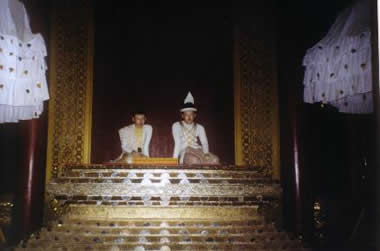
|
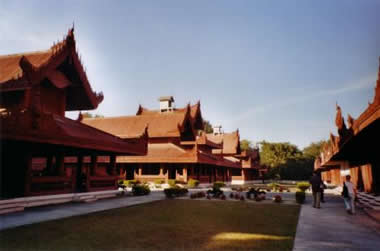 |
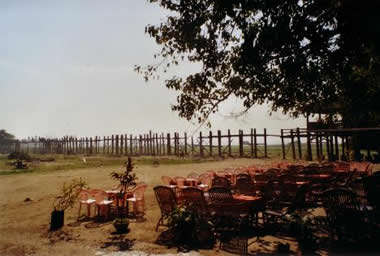 An excursion took us to the Mahagandon Monastry where I became witness to a rather absurd spectacle. It's one of the biggest monastries in Burma with roughly 1500 monks living there. Each morning the monks swarm out to beg for their daily food, which is then collected at the monastry and prepared. At 11am the monks all line up in a seemingly endless queue to receive their midday meal - and this "ceremony" has now turned into a tourist attraction with dozens of chattering, badly-dressed tourists clicking away to their hearts' content as the monks file into the large dining hall to eat. I felt it really lacked respect for them and certainly dignity.
I was glad when we moved on to Taungthaman Lake with the famous U Bein-Bridge, the longest wooden foot bridge in the world (and also the shoddiest one, I'd guess). The area was so peaceful and unspoilt by any modern sights with fishermen quietly going about their business, women washing the laundry at the lake shore and little boats drifting by... it was really a scene from another older Asia, long forgotten in other countries.
An excursion took us to the Mahagandon Monastry where I became witness to a rather absurd spectacle. It's one of the biggest monastries in Burma with roughly 1500 monks living there. Each morning the monks swarm out to beg for their daily food, which is then collected at the monastry and prepared. At 11am the monks all line up in a seemingly endless queue to receive their midday meal - and this "ceremony" has now turned into a tourist attraction with dozens of chattering, badly-dressed tourists clicking away to their hearts' content as the monks file into the large dining hall to eat. I felt it really lacked respect for them and certainly dignity.
I was glad when we moved on to Taungthaman Lake with the famous U Bein-Bridge, the longest wooden foot bridge in the world (and also the shoddiest one, I'd guess). The area was so peaceful and unspoilt by any modern sights with fishermen quietly going about their business, women washing the laundry at the lake shore and little boats drifting by... it was really a scene from another older Asia, long forgotten in other countries.
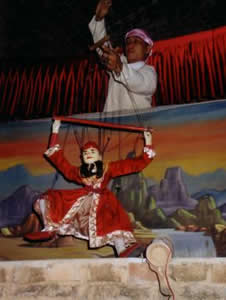 Mandalay itself has some interesting pagodas, including Kuthodaw Pagoda with its 729 little pagodas. The curious numbers results from 729 stone plates on which Buddhist rules and laws have been etched (Moses got off lightly on Sinai!) and each plate now resides in its own little pagoda. The last excursion took us up Mandalay Hill to - surprise! - yet another pagoda and a fabulous view across the town, the Irawaddy River and the far-away hills behind which the sun was just setting. "Sunset on Mandalay Hill" seems to have become a tourist spectacle of its own apparently, because the pagoda's terrace overlooking the town and the hills was absolutely jam-packed with tourists.
Once the sun was gone, we were taken to a lovely outdoor restaurant where we treated to a great meal and puppets. I'm usually not one for folklore evenings, but I did like the show of traditional Burmese puppeteering. Everyone who's ever tried to manipulate a regular six-string-puppet can imagine how good those guys must be who work with a plus-20-strings Burmese puppet.
Mandalay itself has some interesting pagodas, including Kuthodaw Pagoda with its 729 little pagodas. The curious numbers results from 729 stone plates on which Buddhist rules and laws have been etched (Moses got off lightly on Sinai!) and each plate now resides in its own little pagoda. The last excursion took us up Mandalay Hill to - surprise! - yet another pagoda and a fabulous view across the town, the Irawaddy River and the far-away hills behind which the sun was just setting. "Sunset on Mandalay Hill" seems to have become a tourist spectacle of its own apparently, because the pagoda's terrace overlooking the town and the hills was absolutely jam-packed with tourists.
Once the sun was gone, we were taken to a lovely outdoor restaurant where we treated to a great meal and puppets. I'm usually not one for folklore evenings, but I did like the show of traditional Burmese puppeteering. Everyone who's ever tried to manipulate a regular six-string-puppet can imagine how good those guys must be who work with a plus-20-strings Burmese puppet.
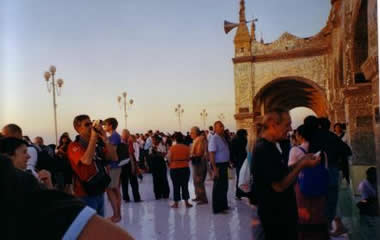
|
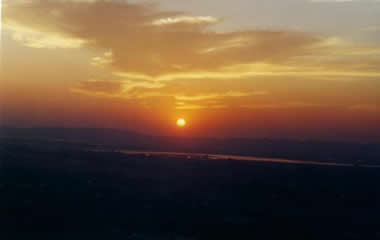 |
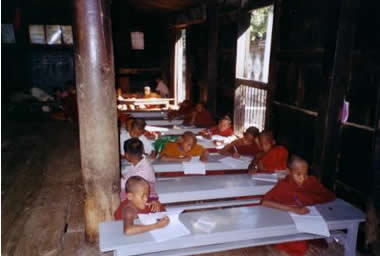 In Mandalay and later at Lake Inle we were taking to several places that gave us an insight on how much is still handcrafted in Burma and how the normal people live. And of course you know that this is also just the nice side of the medal which the government allows you to see. Yet, for someone from a rich modern western country it was fascinating to see how many things are handcrafted there and with how much effort. And of course we also saw many monks in all the pagodas and monastries we visited, for they are an important part of Burmese society.
The guys work in a company producing the fine leaf gold which faithful Buddhists buy to cover Buddha statues and stupas. It takes a good six hours until the gold has been thinned sufficiently - who needs a gym with a job like that? The girls here make "cheroots", the famous Burmese cigars.
In Mandalay and later at Lake Inle we were taking to several places that gave us an insight on how much is still handcrafted in Burma and how the normal people live. And of course you know that this is also just the nice side of the medal which the government allows you to see. Yet, for someone from a rich modern western country it was fascinating to see how many things are handcrafted there and with how much effort. And of course we also saw many monks in all the pagodas and monastries we visited, for they are an important part of Burmese society.
The guys work in a company producing the fine leaf gold which faithful Buddhists buy to cover Buddha statues and stupas. It takes a good six hours until the gold has been thinned sufficiently - who needs a gym with a job like that? The girls here make "cheroots", the famous Burmese cigars.
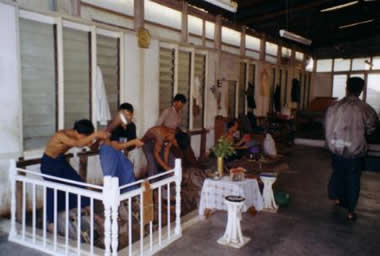
|
 |
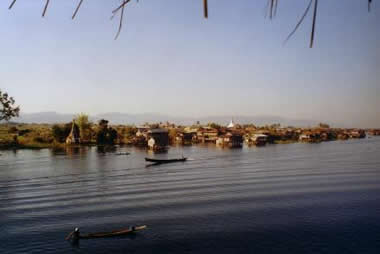
|
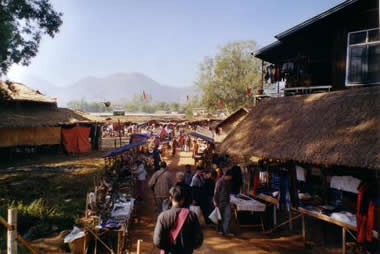 |
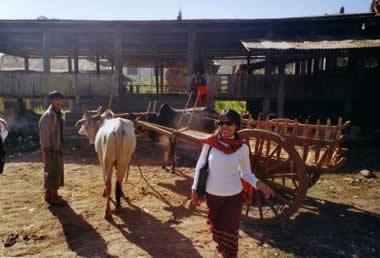
|
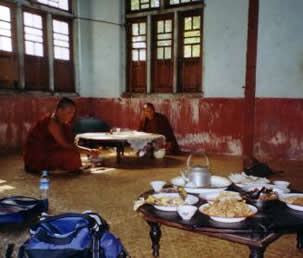 |
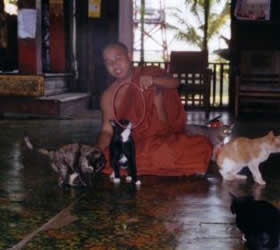 What do monks do when they get bored? They train kitties to jump through hoops. Nga Phe Kyuang Monastry on Lake Inlay is now better-known as The Monastry of the Jumping Cats!
In my opinion though, the best aspect of the stay on Lake Inlay was the night sky. Apart from that one night in the Australian outback when I travelled from Melbourne to Sydney on a night coach, I have never ever seen such a gorgeous radiant night sky. We here in our perpetually lit Western cities have forgotten just how glorious the stars can be in a quiet, dark landscape.
And so we returned to Yangon, where I had two days for myself before returning home. I went shopping on Bogyoke Aung San Market, the main market of Yangon and otherwise just recovered from the journey at the wonderful natural swimming pool of the Kandawgyi Palace Hotel.
What do monks do when they get bored? They train kitties to jump through hoops. Nga Phe Kyuang Monastry on Lake Inlay is now better-known as The Monastry of the Jumping Cats!
In my opinion though, the best aspect of the stay on Lake Inlay was the night sky. Apart from that one night in the Australian outback when I travelled from Melbourne to Sydney on a night coach, I have never ever seen such a gorgeous radiant night sky. We here in our perpetually lit Western cities have forgotten just how glorious the stars can be in a quiet, dark landscape.
And so we returned to Yangon, where I had two days for myself before returning home. I went shopping on Bogyoke Aung San Market, the main market of Yangon and otherwise just recovered from the journey at the wonderful natural swimming pool of the Kandawgyi Palace Hotel.
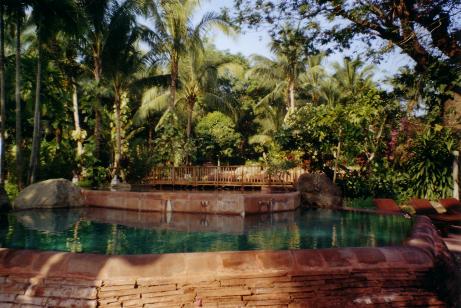
|
 |
Copyright © All Rights Reserved